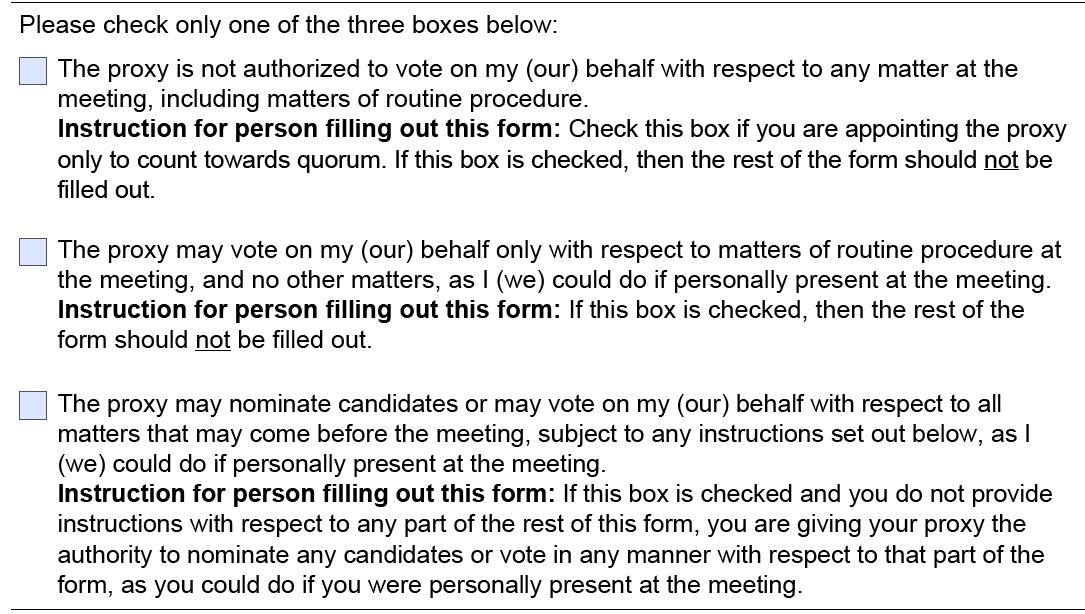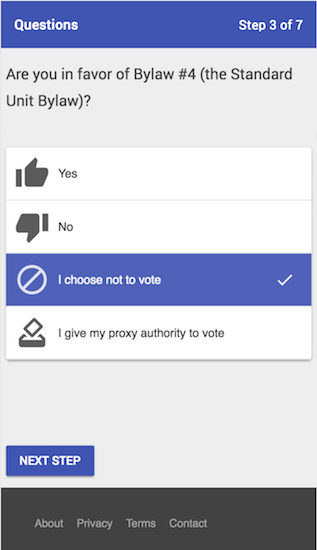As of May 9, 2018, the Ministry has released a new and improved version of their Prescribed Proxy Form. The updated proxy form addresses many of the concerns the condo industry had voiced after the amended Act came into force last November. The updated proxy form has resolved some of the issues that we had raised - making it easier for owners to complete and addressing some of the concerns about proxy holder discretionary voting.
GetQuorum’s electronic proxy system is fully compliant with the updates to the Prescribed Proxy and has already been rolled out.
So what's changed?
Aside from a general reorganization of the form (ie. restructuring of certain sections and making the language clearer) the most substantial changes to the proxy form are as follows:
-
An owner can now explicitly authorize their proxy holder to vote on matters at their own discretion; or
-
An owner can completely restrict their proxy holder from voting on anything, even on matters of routine procedure. The proxy is just there to allow for quorum.
 The "old" prescribed proxy
The "old" prescribed proxy
 The "new" prescribed proxy
The "new" prescribed proxy
This addresses some of the concerns we blogged about not too long ago regarding the proxy being ambiguous when it comes to discretionary proxy voting.
The rest of the form is substantially the same, just with sections moved around or hidden unless needed. This makes for a shorter and cleaner form in most cases. The changes are a welcome improvement, for the most part. As previously mentioned the updated proxy form now solves some parts of the discretionary voting debate, but raises another dilemma.
There's no clear option for an owner to refuse to vote on a matter.
As we mentioned in one of our other blog posts, voters have a legal right to abstain or refuse to cast a vote. Look at the following section from the proxy form in which an owner can elect directors. How would you fill it out if you decide you don’t want a vote to be cast on this matter?
 New general election section
New general election section
Remember that these forms are meant to be used by the general public, which includes people that may not have the experience to fully appreciate the nuances of completing these types of forms correctly.
The Experiment
In exchange for a free coffee we asked a sample of twenty people at our co-working space how they’d "abstain" from voting using the updated proxy forms.
- 65% said “don’t check the box”
- 25% said “check the box, leave it blank”
- 10% said “check the box, write in ‘I choose not to vote’”
All of the responses seem like reasonable interpretations at first glance, unfortunately the new language in the proxy form now states:
“...if you do not provide instructions with respect to any part of the rest of this form, you are giving your proxy the authority to nominate any candidates or vote in any manner with respect to that part of the form...”
So this means that the 65% of people above who didn’t check the box would now have their proxy holder cast a vote for them anyways. It could also be argued that the 25% who checked the box and left it blank could also have the proxy holder cast the vote for them. Only the last group of 10% would have their proxy correctly interpreted as not wanting their vote cast.
Our experiment reveals a real problem - specifically that the form still leaves room for misinterpretation of the proxy form if the owner has not filled the section out explicitly. If changes to the Act were meant to protect condo owners, then the forms provided to owners should contain clear instructions so that there is no room for confusion.
What is GetQuorum doing to help?
We are big proponents of consumer protection and believe that the proxy form should capture the intent of the owner when voting. Here's how GetQuorum's electronic proxy system handles the updated requirements:
-
Owners can choose to authorize their proxy to vote at their discretion on a matter; or
-
Owners can choose to not vote and not allow their proxy to vote on a matter
 Voting on a by-law using GetQuorum
Voting on a by-law using GetQuorum
In the case of an owner choosing not to cast their vote in the matters of electing directors, GetQuorum outputs a proxy form like this:
 The owner’s intent is perfectly clear, there’s no ambiguity here
The owner’s intent is perfectly clear, there’s no ambiguity here
Where do we go now?
The Prescribed Proxy form was meant to be a catch-all for every possible permutation of a condo meeting. But, in the attempt to be all things to every meeting type the Ministry had made an overly long and complicated form. Though the updates to the form now addresses some of the issues that had been raised in the condo community, it’s still an imperfect instrument that still allows for misinterpretation of an owner’s voting intentions. Proxy form disputes can be a common occurrence when filled out by hand because of the ambiguity involved when filled out incorrectly.
Fortunately with a guided system like GetQuorum around, owners fill out their proxy perfectly each time. This gives our clients comfort in never having to worry about their owners' proxies and other irregularities.
Are electronic proxies the only way for owners to vote online?
No, in the Amended Act the Ministry now enables condos to permit their owners to vote through “telephonic or electronic means”. These additional ways to vote were part of the number of “mini bylaws” that the Ministry added to the Act to make it easier for corporations to enact more ways for their owners to participate in decision-making processes. These “mini bylaws” can be passed with only a majority vote at a meeting - essentially over 12.5% of owners need to vote “Yes”.
To enable the electronic balloting process, condo corporations will need to hold a bylaw meeting or add the bylaw as an agenda item for their next AGM. Once the bylaw is passed, electronic balloting can be used for future meetings.
Do you want to get electronic balloting setup in your corporation? We can help you pass the electronic voting bylaw using our electronic proxy system. And once we help you pass your bylaw, GetQuorum’s balloting system is ready for your future meetings. Our electronic balloting system has already been used successfully by our non-condo clients.
Need more guidance on passing the electronic balloting mini bylaw? Want to see a demo of our ballot voting in action? Reach out to us.
Splash photo by rawpixel.com on Unsplash

